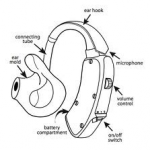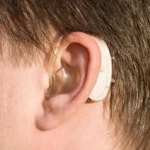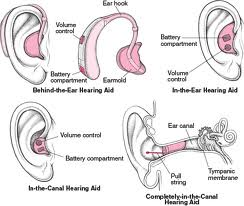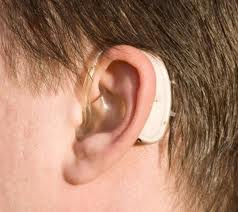Behind-the-ear (BTE) hearing aids fit comfortably behind-the-ear and are attached to a soft custom earmold. With BTE hearing aids, the electronics are housed in a case that fits behind the ear. Sound is directed from the hearing aid, through the tubing, and through the earmold to the eardrum. These hearing aids can be modified with connections to external sound sources such as auditory training equipment, infrared listening systems or television.
 BTE hearing aids can provide more amplification than smaller devices due to the stronger amplifier and the larger battery. This style is available in the programmable, digital, and conventional circuits, and in several colors for hair and skin tone matching.
BTE hearing aids can provide more amplification than smaller devices due to the stronger amplifier and the larger battery. This style is available in the programmable, digital, and conventional circuits, and in several colors for hair and skin tone matching.
Behind The Ear (BTE)
Behind the ear hearing aids have a main shell section, an earmold and a connecting tube. The main shell houses the electronics and the battery – the shell sits at the top of your ear and runs down behind. On the latest hearing-aids the tube that runs from the shell to the ear-piece is very thin and is almost invisible to the casual observer. The design of the earmold varies from model to model; in some it sits in the hollow of the ear, like an ITE; in others it fits more like an ITC aid.
Advantages
- BTE hearing aids can handle all types of hearing losses.
- BTE aids are the cheapest to purchase.
- BTE instruments are suitable for all ages.
- BTE models are normally recommended for children because they are more robust and less likely to get lost; also, due to children’s continuously growing ear canals, it is necessary to replace earmolds regularly, this is simple and cheaper with BTE aids.
- BTE hearing aids can provide the most amplification.
- Most programmable BTE listening devices are available with self-adjusting, or automatic, sound filtering and volume controls that adopt on-the-fly sound changes in the environment of the user. This helps to deliver the best sound quality to the user while eliminating background noises that should not be amplified, making the important sounds of conversation easier to follow.
- With hair and skin tone matching, BTE hearing aids can be cosmetically appealing with placement behind the ear.
- BTE instruments use larger batteries which are easier to handle than the batteries for smaller hearing aids. Another aspect that makes the BTE listening devices a popular choice is that they tend to have better battery life than the “in the ear hearing aids.” This is because the battery does not have to be tucked into a tiny device that fits into the ear canal but can be designed as part of the piece that sits behind the ear. With more space for the hearing aid batteries, larger batteries can be used, which will need to be changed less frequently.
- It is safe to say that generally people prefer not to call attention to their hearing loss by wearing obvious assistive listening devices. Wearing “behind the ear hearing aids” can sometimes be mistaken for wearing a modern Bluetooth headset and this can significantly downplay the issue. This allows people to be less self-conscious about wearing their hearing aid which means they will be more likely to use them as they should.
 Disadvantages
Disadvantages
- An improper fitting or a damaged earmold may cause feedback.
- The earmold may need to be remade periodically to preserve acoustic seal.
- BTE instruments are larger than other hearing aids and can be more noticeable.
Care and maintenance
Diligent and routine care of your hearing aid contributes to outstanding performance and a long service life.
Please use the following specifications as a guideline:
General information
Before using hair spray or applying cosmetics, you should remove your hearing aid from your ear, because these products may damage it.
Daily
Inspect the earmold and tube for earwax and moisture deposits. Clean the surfaces with a lint-free cloth. Never use cleaning agents such as household detergents, soap, etc. for cleaning your hearing aid. If you need to clean your hearing aid intensively, ask your hearing care professional for advice and information on filters or drying capsules.
Weekly
 Clean the earmold with a soft, damp cloth or with a special cleaning cloth for hearing aids. For more in depth maintenance instructions or for more than basic cleaning, please see your hearing care professional.
Clean the earmold with a soft, damp cloth or with a special cleaning cloth for hearing aids. For more in depth maintenance instructions or for more than basic cleaning, please see your hearing care professional.
Monthly
Inspect your hearing tube for color changes, hardening, or cracks. In the case of such changes, the hearing tube has to be replaced. Please see your hearing care professional.
|
Other types of hearing aids |
Hearing aid styles |
|
Programmable hearing aids |
Completely-in-the-canal  (CIC) |
